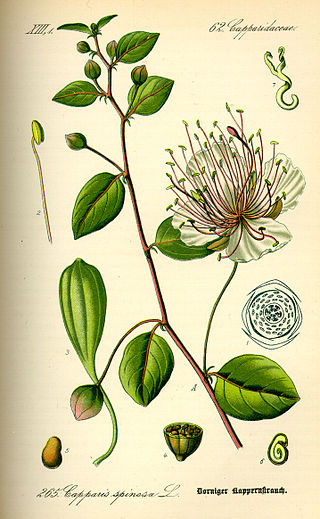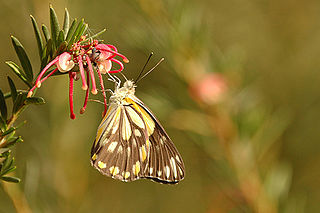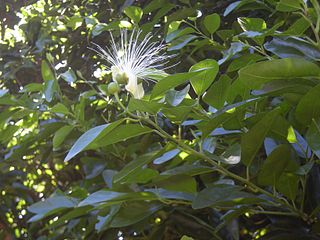
Capparis spinosa, the caper bush, also called Flinders rose, is a perennial plant that bears rounded, fleshy leaves and large white to pinkish-white flowers.

Liriodendron tulipifera—known as the tulip tree, American tulip tree, tulipwood, tuliptree, tulip poplar, whitewood, fiddletree, lynn-tree, hickory-poplar, and yellow-poplar—is the North American representative of the two-species genus Liriodendron, and the tallest eastern hardwood. It is native to eastern North America from Southern Ontario and possibly southern Quebec to Illinois eastward to southwestern Massachusetts and Rhode Island, and south to central Florida and Louisiana. It can grow to more than 50 m (160 ft) in virgin cove forests of the Appalachian Mountains, often with no limbs until it reaches 25–30 m (80–100 ft) in height, making it a very valuable timber tree. The tallest individual at the present time (2021) is one called the Fork Ridge Tulip Tree at a secret location in the Great Smoky Mountains of North Carolina. Repeated measurements by laser and tape-drop have shown it to be 191 feet 10 inches (58.47 m) in height. This is the tallest known individual tree in eastern North America.

Fagus grandifolia, the American beech or North American beech, is the only species of beech native to North America. Its current range comprises the eastern United States, isolated pockets of Mexico and southeastern Canada. Prior to the glacial maximum of the Pleistocene epoch, the tree flourished over most of North America, reaching California.

Coccoloba uvifera is a species of tree and flowering plant in the buckwheat family, Polygonaceae, that is native to coastal beaches throughout tropical America and the Caribbean, including central & southern Florida, the Bahamas, the Greater and Lesser Antilles, and Bermuda. Common names include seagrape and baygrape.
Ponce de Leon Springs State Recreation Area is a Florida State Park in Holmes County, Florida, USA. It is located in the town of Ponce de Leon. The park, which was created to provide public outdoor recreation and other park-related uses, was initially acquired on September 4, 1970, using funds from the Land Acquisition Trust Fund. Its self-proclaimed purpose is to develop, operate and maintain the property for outdoor recreation, park, historic, and related purposes, offering abundant opportunity for nature appreciation and wildlife viewing. Its primary recreational activities include swimming in the spring and hiking along the park's nature trails.

Hibiscus tiliaceus, commonly known as the sea hibiscus or coast cottonwood, is a species of flowering tree in the mallow family, Malvaceae, with a pantropical distribution along coastlines. It has also been introduced to Florida and New Zealand. It has been debated whether this species is native or introduced to Hawaii.

Yucca filamentosa, Adam's needle and thread, is a species of flowering plant in the family Asparagaceae native to the southeastern United States. Growing to 3 metres tall, it is an evergreen shrub valued in horticulture.

Schinus terebinthifolia is a species of flowering plant in the cashew family, Anacardiaceae, that is native to subtropical and tropical South America. Common names include Brazilian peppertree, aroeira, rose pepper, broadleaved pepper tree, wilelaiki, Christmasberry tree and Florida holly. The species name has been very commonly misspelled as ‘terebinthifolius’.

The Capparaceae, commonly known as the caper family, are a family of plants in the order Brassicales. As currently circumscribed, the family contains 15 genera and about 430 species. The largest genera are Capparis, Morisonia, Maerua, Boscia, and Cadaba.

The wild orange is an Australian native plant found in dry inland areas of Australia. Its scientific name is Capparis mitchellii. It is not related to oranges, nor to the Osage-orange which is known as "wild orange" in North America, but to capers.

Tropaeolum majus, the garden nasturtium, nasturtium, Indian cress or monk's cress, is a species of flowering plant in the family Tropaeolaceae, originating in the Andes from Bolivia north to Colombia. An easily-grown annual or short-lived perennial with disc-shaped leaves and brilliant yellow, orange or red flowers, it is of cultivated, probably hybrid origin. It is not closely related to the genus Nasturtium.

Capparis is a genus of flowering plants in the family Capparaceae. It includes 142 species of shrubs or lianas which are collectively known as caper shrubs or caperbushes. Capparis species occur over a wide range of habitat in the subtropical and tropical regions of Africa, Eurasia, Australasia, and the Pacific.

Capparis sandwichiana is a species of flowering plant in the Capparaceae family endemic to the Hawaiian Islands. Common names include maiapilo, pua pilo, and Hawaiian caper. C. sandwichiana can be found on the main islands, Midway Atoll, the Pearl and Hermes Atoll, and Laysan. It inhabits coastal low shrublands and rocky shores at elevations from sea level to 325 feet (99 m). Maiapilo is listed as vulnerable by the IUCN and is threatened by grazing, competition with invasive species, and habitat destruction.

Sabal palmetto, also known as cabbage palm, cabbage palmetto, sabal palm, blue palmetto, Carolina palmetto, common palmetto, Garfield's tree, and swamp cabbage, is one of 15 species of palmetto palm. It is native to the Southern United States, the Yucatán Peninsula in Mexico, and the West Indies.

Belenois java, the caper white or common white, is a small butterfly of the family Pieridae found in Australia, Indonesia, and Melanesia. It is highly migratory and is often confused with the cabbage white.

Capparis arborea is a bush or small tree occurring in eastern Australia. The habitat is rainforest; usually riverine, littoral or the drier rainforests. Distributed from the Hunter River, New South Wales to Cape Melville in tropical Queensland. Common names include native pomegranate, wild lime, wild lemon and brush caper berry.

Passiflora suberosa is a species of passionflower that is native to the Americas. It is commonly known as corkystem passionflower due to the corkiness of older stems. Other common names include corky passion vine, cork-bark passion flower, corkstem passionflower and corky passionfruit. In Latin America it is called Meloncillo. It is possibly also cryptic and have multiple species in one.

Capparis tomentosa, the woolly caper bush or African caper, is a plant in the family Capparaceae and is native to Africa.

Capparis fascicularis, the zigzag caper-bush, is a plant in the Capparaceae family and is native to Africa.

Capparis lasiantha is an endemic Australian plant with a range that extends from the Kimberley region through the Northern Territory and Queensland to northern New South Wales, primarily in drier inland areas although the species extends to the coast in Central Queensland. Common names are numerous and include wyjeelah, nepine, split jack, nipang creeper, nipan, native orange and bush caper.






















